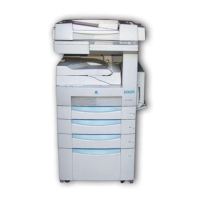FrameMaker Ver.5.5E(PC) Di350 GENERAL, MECHANICAL/ELECTRICAL
98.12.18
M-2
1171SBM0200A
2 COPYING PROCESS
1. PC Drum
•
The drum is an aluminum cylinder coated with photosensitive material on which an elec-
trostatic latent image is produced.
2. Drum Charging
•
A scorotron charger employing a comb electrode generates a negative DC charged
layer on the surface of the PC Drum.
3. Photoelectric Conversion Section
•
The Exposure Lamp directs light onto the original. The light reflected off the original is
directed and resized by the mirrors and lens so as to produce a reduced-size image on
the CCD Sensor.
4. HGB Board
•
Converts an electric signal into a corresponding 8-bit digital image signal (A/D conver-
sion), makes various corrections, and outputs the results to the MFB Board.
5. MFB Board
•
Compresses the image data received from the HGB Board, stores it, and uncom-
presses it.
6. Laser Exposure
•
The laser beam emitted from the LD (laser diode) strikes the surface of the PC Drum,
creating an electrostatic latent image.
7. Development
•
Negatively charged toner adheres to the latent image on the PC Drum surface, creating
a visible image.
8. Paper Feed
•
Feeds sheets of paper from the appropriate paper source.
9. Image Transfer
•
An Image Transfer Roller is used. A positive charge applied to the roller causes the vis-
ible image on the surface of the PC Drum to transfer onto the front side of the paper.
4. HGB Board
5. MFB Board 1. PC Drum
10. Paper Separation
9. Image Transfer
8. Paper Feed
7. Development
2. Drum Charging
12. Cleaning
15. Paper Exit 14. Fusing
8. Paper Feed
3. Photoelectric Conversion
Section
13. Erase
6. Laser Exposure
11. Duplex Unit

